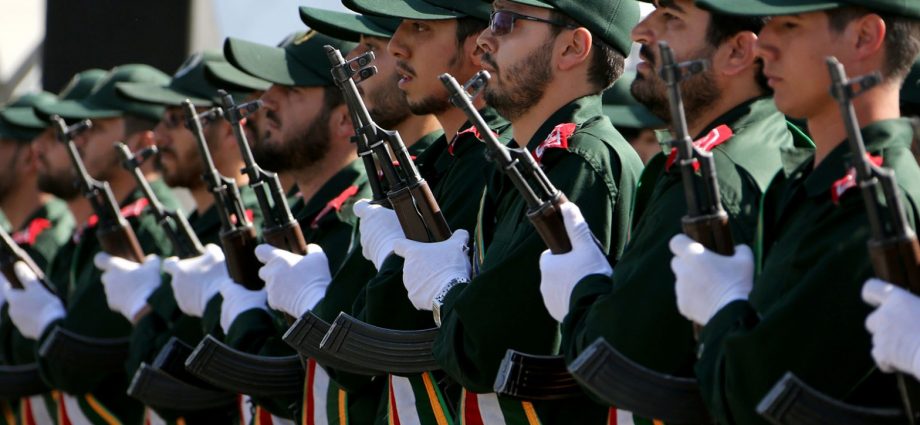Iran tested this month its indigenously-produced Fath 360 satellite-guided ballistic missile during military exercises, an apparent bid to match America’s High Mobility Artillery Rocket System (HIMARS) that has been deployed with lethal success in Ukraine.
Fars News reported last week that Iran tested its Fath 360 short-range surface-to-surface missile and performed combined arms operations with the system during the Eghtedar 1401 military drills at Nasrabad, Isfahan.
The missiles can be fired at Mach 3, after which they connect to satellites for rapid homing and strike their targets at Mach 4, state-owned Tasnim News reported. The Iran Press News Agency said the Fath 360 is downsized member of the Fateh ballistic missile family, allowing it to fit more missiles on a truck, carrier or launcher.
The Fath 360 is four meters long with a diameter of 30 centimeters, 850-1,100-kilogram weight, 150-kilogram warhead and 80–100-kilometer range. Its relatively small and lightweight dimensions allow multiple missiles to be mounted on a truck-based launcher, with six, four, or two-round launch canisters available.
Those specifications make the Fath 360 roughly comparable to HIMARS on paper. Global Security notes that the M31 GMLRS rocket that the US has supplied for Ukraine’s HIMARS units carries a 90-kilogram unitary warhead up to 70 kilometers at Mach 2.5 and can be fired from the six-round HIMARS or the heavier 12-round M270 MLRS which the UK has sent as military assistance to Ukraine.
Eurasian Times mentions that the HIMARS rockets are accurate to five to 10 meters from their point of impact and that a six-rocket salvo could be launched in 25-30 seconds.
Each HIMARS launcher has a US$5.6 million price tag, with the M13 round costing US$168,000, notes Howard Altman in an article for The Warzone. He also mentions that the US is developing an Extended Range GMLRS (ER GMLRS) rocket with a 150-kilometer range that is slated to enter production in 2023.
Iran Press News Agency reports that the Fath 360 was delivered to the Islamic Revolutionary Guards Corps (IRGC) last year, with the two and four-round launchers enabling the IRGC Ground Force to deliver accurate short-range massed fire against enemy air defense systems while freeing the IRGC Aerospace Forces to conduct longer-range strikes.

The Fath 360 may also mark a trend towards smaller wheeled multiple launcher rocket systems (MLRS). Large and heavy systems such as the US M270 MLRS and Russian B-300 Smerch pack formidable firepower holding a dozen rockets each. However, these systems, powerful as they are, have drawbacks.
In an article for Newsweek, Retired US Army General Mark Hertling notes that the wheeled HIMARS is nimbler than its heavier-tracked M270 cousin.
Hertling mentioned heavier tracked systems such as the M270 are more challenging to maintain and fix than HIMARS, a missile launcher mounted on a truck. He also says that HIMARS’ smaller size allows a smaller crew to shoot, scoot and reload faster with fewer soldiers and easier training requirements.
These advantages appear to be reflected in Iran’s Fath 360 system, lending itself to Iran’s asymmetric warfare doctrine and cost-effective means of maintaining effective fighting forces despite international sanctions, budget shortfalls and technical shortcomings.
In a 2020 article by the Washington Institute For Near East Policy, director Michael Eisenstadt notes Iran’s approach to effect a revolution in military affairs enables significant leaps in capability. Although it may be implausible for Iran to consider wholesale military modernization, it still designs simple yet highly capable weapons, allowing it to achieve outsize effects relative to its largely outdated regular military, Eisenstadt notes.
In this connection, Iran may have taken a page from the outsize effect of US-supplied HIMARS launchers in the Ukraine war.
While the New York Times reported that Ukraine had only 26 HIMARS launchers and undisclosed numbers of M31 rounds as of early September, Ukrainian soldiers have taken advantage of HIMARS’ speed and mobility, allowing them to reload quickly while avoiding Russian counter-battery fire.
Similarly, the Fath 360’s light-wheeled configuration potentially makes it more versatile in maneuver warfare in Iran and the Middle East’s mountainous, desert and urban areas compared to the heavier Fateh and Fajr launchers.
Moreover, its smaller size and signature compared to the Fateh and Fajr may also increase its survivability using the shoot-and-scoot tactics employed by Hamas and Hezbollah against Israel and the Houthis against Saudi Arabia with less-sophisticated truck-mounted rocket launchers.
The effectiveness of HIMARS in Ukraine has also been powered by US intelligence supplied to Ukraine. In a separate article this month, the New York Times noted that US intelligence has been critical in enabling Ukraine’s HIMARS batteries to target Russian command posts and ammunition depots, kill senior generals and force ammunition piles to be moved further from the front lines.

While Ukraine’s small number of HIMARS launchers may not be enough for widespread use across the front lines, their judicious deployment against high-value targets enabled by real-time intelligence and precision targeting has allowed them to achieve strategic success on the battlefield.
Iran’s Fath 360 may most likely use Russia’s GLONASS satellite navigation system for targeting data. Russia reportedly gave Iran GLONASS access during the latter’s January 2020 strikes against the US-held Al Asad Airbase in retaliation for the US killing of IRGC General Qassem Soleimani, as reported by Defense World.
The source mentions that Iran fired 19 missiles from its territory during that assault, 17 of which hit their targets.

